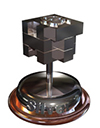Konklusion

AMD Athlon X4 635 viser sig som et stærkt kort i kampen om mellemklassen for cpu'er. 635 chippen kan måle sig med en Intel Core 2 Quad Q8300 og en Core i3 540, både på pris og ydelse. Og så har AMD den store fordel at de ikke på forhånd har kvalt salget ved at tvinge folk til at opgradere resten af deres maskine sammen med cpu'en. De fleste eksisterende AM2+ og AM3 bundkort kan bruges sammen med Athlon II serien, blot ved at opdatere bundkortets BIOS. Og her har vi nok grunden til at AMD fortsat er på markedet. Man har tænkt sig om da man designede platformen, og sørget for at tænke fremad.
Innovation/Teknologi - 3
Det er en nedskaleret udgave af AMD's ellers udmærkede Phenom II arkitektur der er taget i brug, for at skabe en billig, men stadig relativt højtydende firekerner processor. For bare få år tilbage var det ren fantasi at have quad-core cpu'er i mellemklassen. Men AMD har gennem en fornuftig tilgang til fremstilling og hele måden Phenom arkitekturen er skruet sammen på, formået at skabe en ret kraftig cpu, der trods manglen på Phenom seriens L3 cache, har en acceptabel ydelse.
Ydelse - 4
I mange tilfælde vil Athlon II X4 635 være langsommere end en tilsvarende clocket Phenom II X2 dualcore, men når det kommer til flertrådede applikationer er der ikke tvivl om at AMD har et stærkt kort på hånden. Har du planer om at bygge en maskine til hjemmebrug med masser af multitasking for øje, så er 635'eren værd at overveje. Overclocking potentialet er også værd at tage med. I vores test havde vi ingen problemer med at køre alle tests ved 3.625GHz ved hjælp af nogle få justeringer.
Pris - 4
Hvis vi sammenligner pris/ydelse med Intels cpu'er, så står det meget lige mellem de to kombatanter. Men der hvor AMD har en stor fordel er på platformen. Hvis du i forvejen er indehaver af et AMD baseret system fra forrige generation med AM2+ sokkel og DDR2 ram, så kan du uden store problemer købe en af de nye AM3 cpu'er og på den måde opgradere til en billig penge. Hvis du vil opgradere forrige generation Intel skal du skite både cpu, bundkort, og i mange tilfælde også ram.
Test: AMD Athlon II X4 635
| Innovation / Teknologi | 3 |
| Ydelse | 4 |
| Pris | 4 |
| |
| Samlet | 73% |
Læs om vores forklaring på ratingen
herRead about our ratings
hereUK summary

The AMD Athlon II X4 635 turns out to be a strong contender in the fight for the midrange cpu class. The 635 cpu can in most cases perform on par with Intels Q8300 and/or Core i3 540, and has the same pricetag. Furthermore AMD has the advantage of not having killed all chances of sale by changing their platforms. Most AM2+, and o fcourse AM3, motherboards are able to work with the latest additions to the AMD portfolio. This is probably what has kept AMD in the market for so long - smart planning and thinking ahead.
Innovation/Technology - 3
The Athlon II is a scaled down version of the Phenom II architecture, to create a cheap but still relatively high performing quad core cpu. Just a few years ago cheap midrange quads existed only in the imagination of hardcore nerds. But AMD have managed to produce just that, through a smart approach to manufacturing and the scalable cpu architecture behind it all. The 635, despite the lack of L3 cache, still performs well enough to satisfy most users.
Performance - 4
In many cases the Athlon II X4 635 will be outperformed by cheaper the Phenom X2 dual cores, but make no mistake. When it comes to multithreaded applications the 635 packs a punch. If you have plans of building a PC for home or office use with a lot of multitasking in mind, this cpu is worth considering. The overclocking potential is also worth noticing. In our test wee no problems running all benchmarks at 3.625GHz, with just a few adjustments.
Price - 4
A price/performance comparison with Intels midrange offerings, is very close to a draw. But AMD still has the major advantage of not having changed their entire platform lineup to incompatible products. If you own an AM2+ motherboard from the last generation, you will be able to use the latest AMD cpu's with no problems, reducing the cost of upgrading conciderably. Try to do the same with an Intel system, and you will often end up having to change both cpu, mainboard and in most cases memory as well.





